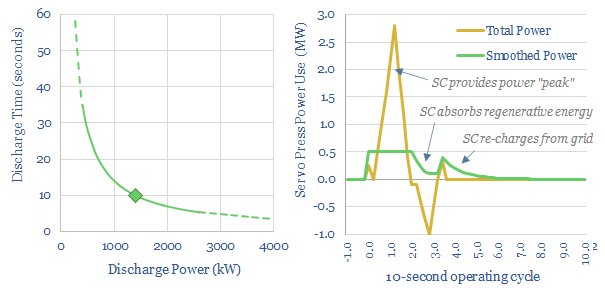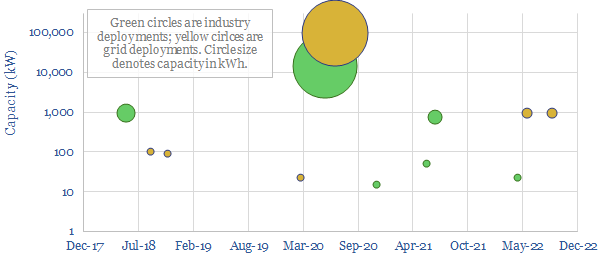The purpose of this data-file is to review supercapacitor case studies, to see if they are being used to back up renewable-heavy grids? Our conclusion is that super-capacitors are well-suited to backstopping short-term wind and solar volatility, and their deployment will gradually surprise to the upside, in combination with other power-electronics.
The motivation for this work is that we recently evaluated the second-by-second volatility of solar and wind output, which incur 80-100 volatility events per day, of which c70-80% last less than 60-seconds. In turn, this volatility profile is well suited to be backed up by super-capacitors, directly, or in combination with other batteries such as lithium ion. So do case studies show increasing deployment of super-capacitors?
The build-up in our data-file has aggregated a dozen recent examples of super-capacitor deployments, based on the disclosures from leading companies, such as Skeleton, Eaton, Vinatech. Many companies endorsed the logic above (quoted in the data-file). Installations typically range from 10kW to 10MW, with 5 – 30 seconds of energy storage (chart below-left), and costs of $30/kW.

Advantages of super-capacitors, cited in many of the case studies, are very rapid responses (20 milliseconds), up to 1M charge-discharge cycles over 15-years (i.e., very low degradation) and safe functionality across wide-temperature ranges (-40ºC to +65ºC). Again, details are in the data-file.
Uses of super-capacitors are broadening. Short-term volatility events may cause $100bn pa of damage to electrical equipment. Around 100,000 wind turbines now use super-capacitors to feather their blades. Many industrial machines also have jagged power demand profiles (example above right, a servo-press used to stamp metal plates in auto-manufacturing). Peak power draw can be reduced over 80% with ultracapacitors. This matters as ‘peak power use’ can explain 50% of industrial power bills.
At grid scale, progress is slowly accelerating. One excellent case study from Eaton highlighted how a data-center could earn €50k per year by providing 1MW of demand-smoothing, kicking in within <1-second to prevent frequency drops in an increasingly renewable-heavy grid. Vinatech also noted a MW-scale super-capacitor in Korea, deemed to be more cost-effective and safe than other grid-scale batteries.
Our conclusion from these supercapacitor case studies is that this market will likely surprise to the upside. Ultracapacitors are particularly well-suited to back up the short-term volatility of renewables. But the trend is opaque, as many of the super-capacitor installations overleaf are small, not subject to the fanfare of large press releases, and integrated alongside other power electronics.

